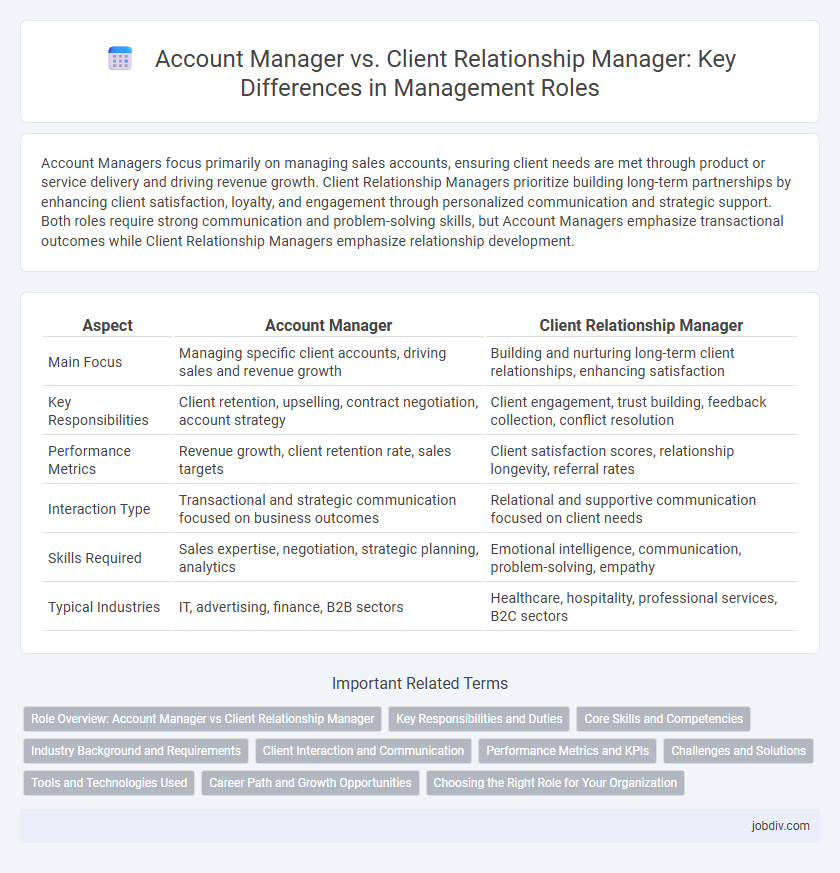Account Managers focus primarily on managing sales accounts, ensuring client needs are met through product or service delivery and driving revenue growth. Client Relationship Managers prioritize building long-term partnerships by enhancing client satisfaction, loyalty, and engagement through personalized communication and strategic support. Both roles require strong communication and problem-solving skills, but Account Managers emphasize transactional outcomes while Client Relationship Managers emphasize relationship development.
Table of Comparison
| Aspect | Account Manager | Client Relationship Manager |
|---|---|---|
| Main Focus | Managing specific client accounts, driving sales and revenue growth | Building and nurturing long-term client relationships, enhancing satisfaction |
| Key Responsibilities | Client retention, upselling, contract negotiation, account strategy | Client engagement, trust building, feedback collection, conflict resolution |
| Performance Metrics | Revenue growth, client retention rate, sales targets | Client satisfaction scores, relationship longevity, referral rates |
| Interaction Type | Transactional and strategic communication focused on business outcomes | Relational and supportive communication focused on client needs |
| Skills Required | Sales expertise, negotiation, strategic planning, analytics | Emotional intelligence, communication, problem-solving, empathy |
| Typical Industries | IT, advertising, finance, B2B sectors | Healthcare, hospitality, professional services, B2C sectors |
Role Overview: Account Manager vs Client Relationship Manager
Account Managers primarily focus on managing client accounts by ensuring the delivery of products and services, meeting sales targets, and handling contract negotiations. Client Relationship Managers concentrate on building long-term relationships, improving client satisfaction, and fostering loyalty through personalized communication and strategic engagement. Both roles emphasize client retention but differ in their approach: Account Managers drive revenue through account growth, while Client Relationship Managers enhance overall client experience and trust.
Key Responsibilities and Duties
Account Managers oversee client accounts by managing project deliverables, coordinating internal teams, and ensuring contract compliance to achieve revenue targets. Client Relationship Managers focus on nurturing long-term client partnerships through regular communication, addressing client needs, and enhancing customer satisfaction to drive loyalty and retention. Both roles require strategic planning and problem-solving skills but differ in their emphasis on operational execution versus relationship cultivation.
Core Skills and Competencies
Account Managers excel in sales expertise, revenue growth strategies, and product knowledge, driving client acquisition and retention through negotiation and contract management skills. Client Relationship Managers prioritize communication, conflict resolution, and emotional intelligence to foster long-term partnerships and ensure customer satisfaction. Both roles require project management abilities, but Account Managers lean towards achieving targets, while Client Relationship Managers emphasize relationship-building and loyalty.
Industry Background and Requirements
Account Managers typically operate in sales-driven industries such as advertising, technology, and finance, requiring strong negotiation skills and a deep understanding of product portfolios to drive revenue growth. Client Relationship Managers are more common in service-oriented sectors like consulting, healthcare, and banking, emphasizing client retention, satisfaction, and long-term relationship building through excellent communication and problem-solving abilities. Both roles demand industry-specific expertise and the ability to manage multiple stakeholders effectively, but the core focus differs with Account Managers prioritizing sales targets and Client Relationship Managers focusing on service quality and trust development.
Client Interaction and Communication
Account Managers focus on maintaining ongoing client accounts by delivering project updates, addressing concerns, and ensuring contract compliance, emphasizing transactional communication. Client Relationship Managers prioritize building long-term, trust-based relationships through personalized interactions, strategic dialogue, and proactive problem-solving to enhance client satisfaction and loyalty. Effective client interaction for Account Managers centers on operational efficiency, while Client Relationship Managers drive deeper engagement to foster business growth.
Performance Metrics and KPIs
Account Managers are typically evaluated based on sales performance metrics such as revenue growth, client retention rates, and upsell/cross-sell success, emphasizing direct contribution to company profitability. Client Relationship Managers prioritize KPIs related to customer satisfaction scores (CSAT), net promoter score (NPS), and long-term engagement duration, reflecting their role in nurturing and sustaining client partnerships. Organizations often integrate these performance metrics to balance revenue generation with client loyalty and service quality.
Challenges and Solutions
Account Managers often face challenges in balancing multiple client demands while ensuring timely deliverables, which can cause resource strain and communication gaps. Client Relationship Managers encounter difficulties in maintaining long-term trust and anticipating client needs amidst market fluctuations, requiring proactive engagement and personalized strategies. Implementing advanced CRM tools and fostering cross-functional collaboration help both roles streamline workflows, enhance client satisfaction, and mitigate operational risks.
Tools and Technologies Used
Account Managers commonly utilize CRM software like Salesforce and HubSpot to track sales pipelines, manage client accounts, and generate performance reports. Client Relationship Managers often rely on communication platforms such as Microsoft Teams, Zoom, and collaboration tools like Slack to maintain continuous client engagement and foster relationships. Both roles leverage data analytics tools like Tableau or Power BI to interpret client data, optimize strategies, and enhance customer satisfaction metrics.
Career Path and Growth Opportunities
Account Managers typically progress through roles in sales or customer service, advancing to senior account or sales management positions, leveraging skills in client acquisition and revenue generation. Client Relationship Managers often transition into strategic roles such as customer experience director or client success leadership, focusing on long-term engagement and retention strategies. Both career paths offer growth opportunities in leadership, but Account Managers emphasize transactional growth while Client Relationship Managers prioritize relational and strategic development.
Choosing the Right Role for Your Organization
Selecting the ideal role between an Account Manager and a Client Relationship Manager depends on your organization's strategic priorities and client engagement goals. Account Managers specialize in managing sales cycles, contract renewals, and revenue growth within assigned accounts, optimizing account profitability. Client Relationship Managers focus on building long-term client loyalty, enhancing satisfaction, and identifying opportunities for cross-functional collaboration to support customer retention and advocacy.
Account Manager vs Client Relationship Manager Infographic

 jobdiv.com
jobdiv.com